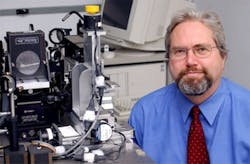University of Rochester researcher wins $630,000 prize for adaptive-optics research
Rochester, NY--David Williams, a faculty member of the University of Rochester’s Institute of Optics, director of its Center for Visual Science, and dean for research in Arts, Science, and Engineering, will receive the António Champalimaud Vision Award at a ceremony today in Lisbon, Portugal.
The ceremony, chaired by the president of Portugal, will recognize Williams’ work on adaptive optics technologies as a “major breakthrough in the understanding and/or the preservation of vision.” Williams is widely regarded as one of the world’s leading experts on human vision.
Substantial award
The Champalimaud Award is given in even numbered years and awards one million Euros for contributions to vision research, by far the largest amount of any award in the fields of vision science and ophthalmology. Williams will be taking half of the prize, about $630,000 toward future research.
Williams' prize is shared with the developers of optical coherence tomography (OCT), another method of imaging the retina that has improved the diagnosis and clinical management of retinal disease.
Williams said he was delighted to share the award, as “together these two technologies make it possible for us to image the retina with unsurpassed resolution and move us further down the path to understanding of retinal disease.”
He called the discoveries in adaptive optics “the work of many graduate students, postdoctoral fellows, and collaborators over two decades. It is great for our whole community that the achievements and potential of adaptive optics for vision is showcased with this award,” he said.
Adaptive optics was first developed by astronomers so that ground-based telescopes could see more clearly through atmospheric turbulence. The technologies that Williams and his group developed apply these techniques to the eye and make it possible to image individual retinal cells, down to individual cone photoreceptors in the living human retina, by looking through the pupil.
Correction of wavefronts on entry and on exit
The techniques Williams’ group developed can not only correct light wavefronts leaving the eye to better image the retina; they can also correct wavefronts of light entering the eye to produce higher-quality vision. This can improve vision in patients with contact lenses, intraocular lenses, and laser refractive surgery. For example, the methods Williams’ group developed are used in more than half of the LASIK procedures conducted worldwide today.
The jury added that the discoveries of Williams and his colleagues have “demonstrated the potential of optical methods, for both the investigation and the improvement of normal and pathological visual function. They have set the stage for current approaches to vision correction and have opened up new possibilities for imaging retinal structures in the living eye.”

John Wallace | Senior Technical Editor (1998-2022)
John Wallace was with Laser Focus World for nearly 25 years, retiring in late June 2022. He obtained a bachelor's degree in mechanical engineering and physics at Rutgers University and a master's in optical engineering at the University of Rochester. Before becoming an editor, John worked as an engineer at RCA, Exxon, Eastman Kodak, and GCA Corporation.
